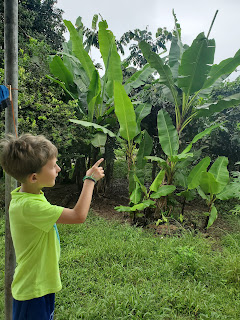Great Backyard Bird Count 2023
I am happy to report that many of our local neighbor children are well aware of our familial bird obsession and regularly come running up our front stairs to report their recent bird observations, borrow the binoculars, and verify which specific bird they spotted in our well-worn bird book. In this way, bird watching has become yet another a community-building experience.
I am sitting on our front porch this very instant, watching a rufous-tailed hummingbird zip across the path and go gangbusters on our banana tree flower. On the wire above my head, two very loud house wrens are singing to each other. Two pairs of hook-billed kites, whose unique calls sound like a high-pitched horse whinny, have been having intense discussions all morning.
We are proud this year to participate for the first time in the annual Great Backyard Bird Count (GBBC#2023), a global event sponsored by Cornell Lab of Ornithology each February.
In all, we ourselves counted 34 different bird species over four days (February 17-20), the first day of which was out at the Ecuadorian coast. On the coast, among others, we counted whimbrels, brown pelicans, saffron finches, and the roseate spoonbill, a uniquely pink bird with an apt-named beak. When we made it back inland to La Josefina, many of our favorite local birds were cooperative enough to present themselves for our count. These included groove-billed ani, fasciated tiger heron, black-cheeked woodpeckers, masked water tyrants, squirrel cuckoos, orange-bellied euphonias, and our very loud flyover team of bronze-winged parrots.
Our family's favorite bird remains the attractive bluish-greenish whooping motmot with his booted tail, who appears on our electrical wire with some regularity. And, over the last month, we have been repeatedly awed by the two pairs of regal hook billed kites who are surely hunting local chicken eggs, rats, snails, and small bird nests in the area around our house.
The GBBC#2023 data is still rolling in, but thus far, citizen scientists from 189 countries participated, observing 7,381 different bird species around the world. Ecuador is currently in second place -- just behind Colombia and ahead of India -- with the number of species counted at 1,067 (14% of birds during four days, 67% of birds known to exist in Ecuador). By far, the overwhelming number of bird lists (184,000) were submitted by people in the US, but Ecuador, a much smaller nation, made a good showing with over 800 lists!
As we grow our bird-spotting skills and our local bird knowledge, we have also been learning to take photos through our binoculars. We don't have a camera with a good zoom lens, so this has become the best way we have to capture images of birds we encounter. These photos are not always as stunning as we might like (or as clear as they would be if we had a camera), but it is a still fun way to preserve some of the evidence of our bird watching successes.
Like many solo activities, bird watching is a personal and flexible hobby that enhances our own experience of the world. But, participating in the GBBC as part of a larger community of citizens and scientists gives our bird watching context and meaning and reminds us of our place in the interdependent web of which we are just a small part.
This interconnected web of all living beings -- from humans to birds to pesky mosquitoes to ceibo trees and yuca roots -- is something I hope my children and I can continue to hold in lifelong relationship.












Do you have many hummingbirds? There are so many that we don't see here in SR, and of course the tropical ones have even better colors. On a trip to Costa Rica we saw at least 6 that were new to us. Curved bills, bigger sizes, great colors, and of course their audacious/fearless/pugnacious style is always part of the fun.
ReplyDelete